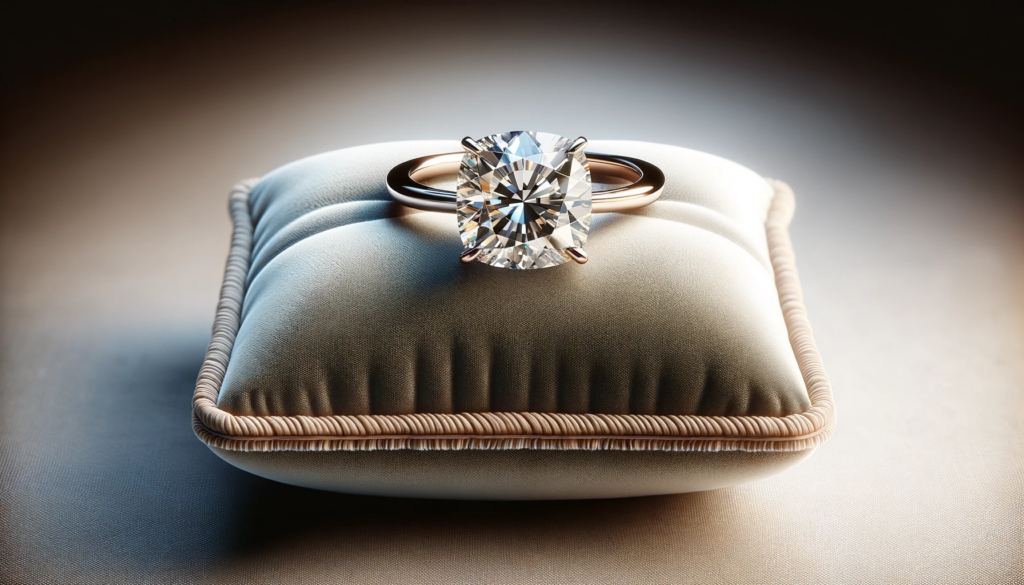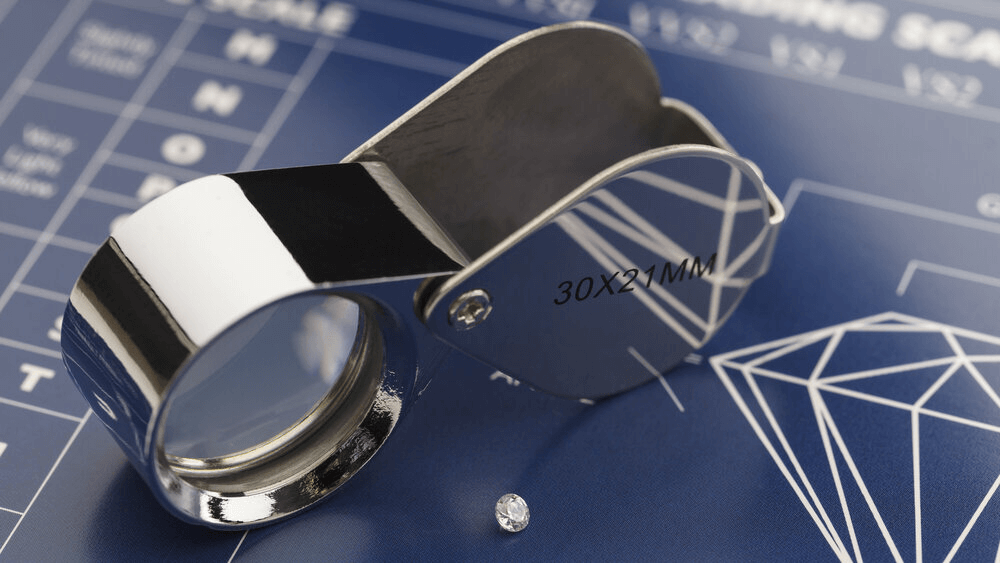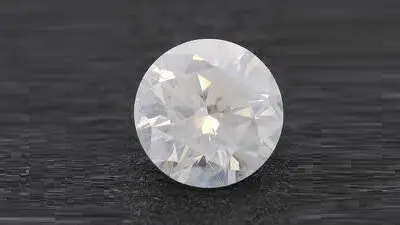Don’t Overpay! Learn Why VS2 Diamonds Offer the Best Value!

By Gary A.

Edited by Olivia H.
Published Jul 4, 2021
Edited on Dec 17, 2024
When it comes to finding the perfect balance between beauty and value, VS2 diamonds offer a stunning clarity that often appears flawless to the naked eye, making them a popular choice for engagement rings without breaking the bank.

- 7 Quick Tips for Examining VS2 Clarity in Diamond Engagement Rings
- Introduction
- What is a VS2 Diamond?
- Understanding VS2 Clarity
- VS2 Diamonds and Eye Cleanliness
- VS2 Diamond Price
- Our Expert Take
- 8 FAQs
Before we dive deeper into the specifics, here are some practical tips to help guide your decision-making process:
7 Quick Tips for Examining VS2 Clarity in Diamond Engagement Rings
When purchasing a diamond engagement ring, especially focusing on VS2 clarity, there are several practical aspects you should consider to ensure you make a well-informed decision. These tips will guide you through the key factors to pay attention to.
- Tip 1: Understand the Clarity Grading System: Familiarize yourself with what VS2 clarity entails. VS2 diamonds have minor inclusions that are typically not visible to the naked eye but can be seen under 10x magnification. Understanding this grading helps set realistic expectations.
- Tip 2: Inspect the Diamond Under Various Lighting Conditions: Examine the diamond under different lighting conditions. While inclusions in VS2 diamonds may not be visible in standard room lighting, certain angles or lights can make them more apparent. View the diamond in natural light, under a jeweler’s lamp, and in dimmer settings.
- Tip 3: Consider the Diamond’s Size and Shape: Remember, the larger the diamond, the more likely inclusions in a VS2 diamond might be visible. Additionally, certain diamond shapes, like round or oval, can hide inclusions better than step cuts like emerald or Asscher.
- Tip 4: Pay Attention to the Inclusion Type and Location: Not all inclusions are created equal. Black carbon spots, large feathers, or centrally located inclusions can be more noticeable. Prioritize diamonds where inclusions are off to the side or near the edges, as they are less likely to impact the stone’s appearance.
- Tip 5: Check for Eye-Cleanliness: While VS2 diamonds are generally considered eye-clean, this can vary. Look at the diamond without magnification and trust your eyesight. If you can see any blemishes or inclusions with the naked eye, you might want to consider another stone.
- Tip 6: Examine the Diamond’s Cut Quality: A well-cut diamond can mask some inclusions and enhance the stone’s overall appearance. Excellent or ideal cut grades often reflect better light performance, which can draw attention away from minor inclusions.
- Tip 7: Review the Diamond Certificate for Details: Always review the diamond’s certification, preferably from a reputable lab like GIA or AGS. The certificate provides a detailed map of the diamond’s inclusions and can give you a better idea of where they are located and how they might affect the overall appearance.
Now that you’ve got these practical tips, use Jeweler AI below to find the perfect engagement ring that suits your style and budget:
Introduction
Face it: there’s no getting around the fact that, for most people, it takes time to really get a grip on the clarity grades. Memorizing their order is one thing but, for many of us, the phrases ‘very very slightly’ or ‘very slightly’ included seem more than a little vague.
Even so, these grades are incredibly useful – not just because they offer a way of sorting through the vast and varied world of diamonds, but also because they leave a certain amount open to interpretation. No two VS2 diamonds are the same, and those inclusions can occur within the diamond in any manner of ways – leading to any number of results.
This is often what we mean when we say that each diamond has its own unique character, and that, while the GIA’s scales are incredibly valuable to anyone looking to purchase a diamond, there are plenty of other factors that give each diamond its own character.
A VS2 diamond is one of the most affordable options for those shopping for beautiful diamonds on the market today, and it represents an ideal starting point as you work to understand how far your budget can take you, and how you can make the very most out of it by getting a beautiful, eye clean and eye-capturing diamond for your bride to be.

What is a VS2 Diamond?
Cushion cut diamond VS2 with VS marked in red
A VS2 diamond is one that has been officially graded by an expert gemologist according to the GIA’s Clarity Scale, and that, more specifically…
- The diamond will have been given a clarity grading of Very Small Inclusions 2 on the GIA scale, and this will be recorded in an official GIA Diamond Report.
- The diamond’s inclusions are unlikely to be visible to the naked eye – or, in other words, the diamond is pretty likely to be considered eye clean.
- The diamond will cost less than a VS1 diamond, unless it is of a significantly different quality (in terms of color or cut) or carat weight.
- The diamond will sit in the ‘sweet spot’ where you can find the most affordable diamonds without sacrificing beauty or investing in visible flaws.
You can browse all VS2 diamonds here, or keep reading to get your head around just why the VS2 diamond grade represents a great place for you to focus your search.

Understanding VS2 Clarity
To understand what a VS2 diamond grading is, it’s important that you first understand the most reputable scale used for evaluating a diamond’s clarity – the GIA grading scale. Sure, you could read ‘VS2 is a good choice for you’ and run with it but, while the GIA’s scales are there to offer an objective overview of every diamond a shopper will encounter, you still need to be able to make your own judgement – and for that, you’ll need to have a solid understanding of the basics.
The Basics of Diamond Clarity
The diamond clarity scale for GIA contains the following grades, with VS2 located between VS1 and SI1 – exactly halfway down the scale.
Internally Flawless (abbreviated as IF), Very Very Small Inclusions 1 (VVS1), Very Very Small Inclusions 2 (VVS2), Very Small Inclusions 1 (VS1), Very Small Inclusions 2 (VS2), Small Inclusions 1 (SI1), Small Inclusions 2 (SI2), Inclusions 1 (I1), Inclusions 2 (I2).
VS2 is a clarity grade that refers to the presence of ‘very slight’ inclusions within a diamond. On the GIA Clarity Scale, it sits between VS1 and SI1 and indicates that inclusions within the diamond are relatively easy to detect under 10x magnification.
VS2 diamonds are still pretty rare, but they are much more common than some of the more technically perfect diamonds out there. As a result, they remain a firm choice among shoppers looking to invest in a quality diamond for their engagement ring – particularly because they are significantly less expensive than VVS diamonds.
Evaluating Diamond VS2 Quality
In a VS2 diamond, the flaws are so small that, in most diamonds, they will require magnification to be seen.
When a gemologist sets about grading the quality of any given diamond, they do so under very specific conditions for light, and with the right equipment to actively seek out those tiny, near-insignificant flaws that all diamonds have.
True, some diamonds are so close to perfect that even the usual magnification tools can’t find them, but neither you, nor your bride-to-be – or even her friend’s, family, or coworkers – will ever scrutinize your diamond under these conditions. Or, at least, we hope…
Evaluating Light Performance in VS2 Diamonds
VS2 diamonds are able to create a stunning performance of brilliance and fire. Like any diamond, a good cut is the secret to ensuring maximum sparkle.
Some round and fancy cuts, such as the Oval and Pear, are much better at hiding inclusions than others. The long, polished facets of the Emerald cut, for instance, are not so effective at obscuring any small flaws that exist within the diamond’s internal structure.
These cuts are also known to be much more sparkly. The complexly arranged facets of the round cut, for instance, create many more opportunities for light performance than the elongated and horizontal facets of the step cuts.
Even still, VS2 Emerald Diamonds will still generally appear eye clean, and, like the VS1 or VVS diamonds, sparkle to their fullest potential on the finger. Inclusions have to be far more significant to mess with the diamond’s light performance.
VS2 Diamonds and Eye Cleanliness
VS2 diamonds appear eye clean – meaning that they offer a very good option to those looking to pick a beautiful diamond without going beyond their means.
However, the inclusions in VS2 diamonds may be slightly visible if the diamond is more than 2.0 carats – and, like we mentioned above, if the diamond features a cut that offers less in the way of camouflage for any inclusions.
Even so, VS2 is a great indicator of eye cleanliness, and a good place to start if you’re looking for an affordable diamond without any visible inclusions. It’s slightly more reliable than SI1, which sits just below VS2 on the clarity grading scale, but, even then, you could find an eye clean stone.

VS2 Diamond Price
Chances are, you’re interested in learning more about VS2 diamonds out of a desire to maximize your budget and find the best possible diamond for the best possible price. So, with that in mind, here’s everything you need to know about the value of a VS2 graded diamond.
The Investment Value of VS2 Diamonds
An all-round good quality VS2 diamond could be priced anywhere from $3,000 to $10,000, although certain cuts (such as the round cuts) and color grades will raise that minimum price higher.
VS2 diamonds are considered to be far better investments than VVS diamonds – a fact which means that, while they’re much, much more affordable, they still come with a premium price. Only by purchasing a diamond with visible inclusions that interfere quite significantly with the diamond’s appearance can you hope to find a ‘cheap’ diamond – but remember that ‘cheap’ does not mean ‘good investment’.
Value for Money: VS1 vs VS2
While the clarity grades offer an indispensable tool for working out whether a diamond is up your alley, or too wide of the mark to bother, it can be tricky to work out exactly what separates a VVS1 diamond from a VVS2 diamond, or, in this instance, a VS1 diamond from a VS2 diamond.
Put simply, a VS1 diamond will be a little more expensive than a VS2 diamond.
Although there’s only 1 grade separating one from the other, the price difference can get as high as $1,000. It’s understandable why newcomers are willing to pay that price, but it is also totally unnecessary and could prevent those buyers from getting a diamond that is as big or as colorless as they would like.
Buying a VS1 diamond online will give you a higher guarantee of eye cleanliness – but, if you’re shopping from a reputable seller who checks each diamond first, you don’t need to worry about getting any unwanted surprises when the diamond arrives.
VS2 is the clarity grade where you can find the most affordable diamonds without sacrificing beauty, but that’s not to say that every VS2 diamond will look flawless.

More for Less: VS2 vs SI1
So, if the difference between one clarity grade and another is only marginal, and not generally worth the three or four-figure difference in value between two visually similar diamonds, how far down the scale can you go before that logic is no longer useful? Can you dip down into the next category, and opt instead for a Slightly Included diamond?
If you’re only going by the GIA’s Clarity Scale. SI2 means that the diamond features Slight Inclusions, which means that inclusions are easily noticeable under 10x magnification.
For that reason, it is still possible to find an eye clean SI1 diamond – though, again, size does matter, and a particularly large SI1 diamond may not look quite as impressive and flawless as a smaller SI1 diamond.
Still, the question over VS2 vs SI1 is definitely worth considering in much more detail, as opting for this slightly lower grade can pay off in some instances – but not in others.
Our Expert Take
VS2 diamonds are, in all likelihood, going to appear to your eye as identical to VVS diamonds, which could cost thousands of dollars more despite the fact that the VS2 diamond’s flaws are too small to impact its appearance.
Remember that you need to be investing in the visual qualities of the diamond, rather than simply investing in what’s printed in its diamond report. The appearance of flawlessness is as valuable to you as true flawlessness, just as the appearance of colorlessness is just as valuable to you as a color grade of D – although it will work out to be thousands of dollars cheaper.
So, yes, an eye clean VS2 diamond is worth its weight in gold, although it won’t break the bank. Just don’t underestimate the importance of your own appraisal of the diamond – for, even though you won’t see what a gemologist or jeweler sees, your own opinion counts for a great deal when it comes to eye cleanliness.
8 FAQs
- Q: What Does “VS2” Stand for in Diamond Grading?
A: VS2 stands for “Very Slightly Included 2nd Degree,” indicating minor inclusions that are challenging to see under 10x magnification and typically invisible to the naked eye. - Q: Are VS2 Clarity Diamonds Eye-Clean?
A: Most VS2 diamonds are considered eye-clean, meaning their inclusions are not visible to the naked eye. However, this can vary based on the size and location of the inclusions. - Q: How Does VS2 Clarity Affect a Diamond’s Price?
A: VS2 diamonds are more affordable than higher clarity grades like VVS or IF, offering a balance between quality and value, making them a popular choice for engagement rings. - Q: Is a VS2 Diamond a Good Investment?
A: VS2 diamonds can be a good investment. They maintain a strong resale value and are in high demand due to their balance between affordability and aesthetic appeal. - Q: Can the Inclusions in a VS2 Diamond Affect Its Durability?
A: The inclusions in a VS2 diamond are usually not significant enough to affect its structural integrity and durability. They are primarily an aesthetic consideration. - Q: Should I Choose a VS2 Diamond for My Engagement Ring?
A: A VS2 diamond can be an excellent choice for an engagement ring, offering an attractive balance of clarity, appearance, and value. It’s especially suitable if you prioritize a larger stone or a specific setting while staying within a budget. - Q: How Can I Tell if a VS2 Diamond is Authentic?
A: To ensure the authenticity of a VS2 diamond, always look for a certificate from a reputable grading entity like the GIA (Gemological Institute of America) or AGS (American Gem Society). - Q: What’s the Difference Between VS2 and SI1 Clarity?
A: VS2 diamonds have fewer and less noticeable inclusions compared to SI1 diamonds. Inclusions in SI1 diamonds may be visible to the naked eye, unlike most VS2 diamonds.
Discover your perfect VS2 diamond with Jeweler AI – Precision meets elegance in every recommendation.
FOLLOW-UP GUIDE SERIES





















